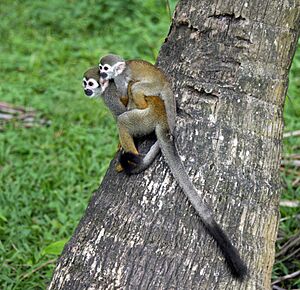Guianan squirrel monkey facts for kids
The Guianan squirrel monkey (Saimiri sciureus) is a small, active monkey found in parts of Guiana, Venezuela, and Brazil. For a long time, scientists thought this monkey was the same as other squirrel monkeys. But newer studies have shown that it is its own special kind of monkey!
Quick facts for kids Guianan squirrel monkey |
|
|---|---|
 |
|
| Conservation status | |
| Scientific classification | |
| Genus: |
Saimiri
|
| Species: |
sciureus
|
 |
|
| Guianan squirrel monkey range shown in green | |
| Synonyms | |
|
Simia sciurea Linnaeus, 1758 |
|
Contents
About the Guianan Squirrel Monkey
For many years, different types of squirrel monkeys were all thought to be one species called the "common squirrel monkey." This group had a very wide home range across the northern part of South America.
However, scientists kept studying these monkeys. In 2009, a study looked at their genes. It showed that the Humboldt's squirrel monkey, found in Colombia, Peru, and Ecuador, was actually a different species. It was more closely related to other squirrel monkeys than to the Guianan one.
Then, in 2015, another genetic study was done. This study found that Collins' squirrel monkey, which lives in northeastern Brazil, was also a separate species. These discoveries meant that the name Saimiri sciureus now only refers to the squirrel monkeys living in northern Brazil and the Guianas.
It's interesting to know that even though they live far apart, the Guianan squirrel monkey's closest relative is the Central American squirrel monkey. This monkey lives all the way in Costa Rica and Panama!
What They Look Like
Male Guianan squirrel monkeys have a body that is about 25 to 37 centimeters (10 to 15 inches) long. Their tail is usually between 36 and 40 centimeters (14 to 16 inches) long.
Female monkeys are a bit smaller. Their bodies are about 25 to 34 centimeters (10 to 13 inches) long. Their tails can be a bit longer, from 36 to 47 centimeters (14 to 19 inches).
Males weigh between 550 and 1400 grams (19 to 49 ounces). Females weigh between 550 and 1200 grams (19 to 42 ounces).
These monkeys have a pink face with a black nose and mouth area. They have white fur that forms arches above their eyes. The top of their head is usually olive green or olive gray. The fur on their back can be gray, olive, or orange. But their belly is always white, and their arms are a bright yellow-orange color.
How Guianan Squirrel Monkeys Live
Guianan squirrel monkeys often travel and eat together with other types of monkeys. They are often seen with capuchin monkeys and also with the red-backed bearded saki. Sometimes, where their homes meet, they can even have babies with bare-eared squirrel monkeys. These babies are called hybrids.
Their diet is quite varied! They eat many different things, including:
- Insects
- Seeds
- Fruit
- Young leaves and flowers
- Tree sap (gum) and shoots
- Nectar
- Spiders
- Lizards
- Bird eggs
Once, a Guianan squirrel monkey was even seen eating a bat! However, they don't seem to hunt bats as often as their relatives, the Central American squirrel monkeys.
Reproduction and Life Cycle
When it's time to have babies, all the females in a group usually give birth around the same time. Before the mating season, male monkeys gain weight in their upper bodies. They also become more aggressive. Females do not seem to start the mating process.
A female monkey is pregnant for about 5 months. All the babies in a group are usually born within one week of each other, often in January or February. Male monkeys do not help care for the babies. However, other females in the group, who are not the mother, often help look after the young. This is called alloparental care.
Baby monkeys have tails that can slightly grasp things. They stop drinking their mother's milk at about 6 months old. Females can have their own babies when they are about 2 and a half years old. Males are fully grown and ready to mate when they are 4 or 5 years old. Guianan squirrel monkeys can live for more than 20 years!
See also
 In Spanish: Mono ardilla común para niños
In Spanish: Mono ardilla común para niños


